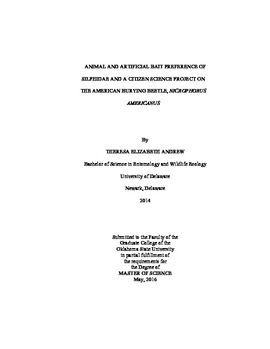| dc.description.abstract | Carrion beetles (Coleoptera: Silphidae) utilize vertebrate carcasses for feeding and reproduction.� These beetles find carcasses using chemoreceptors located on their antennae which detect volatiles released during decomposition.� Surveys for carrion beetles, including the federally endangered American burying beetle,�Nicrophorus americanus (Olivier), utilize various bait types ranging from whole laboratory rats to parts of chicken that are rotted at warm temperatures for several days.� Environmental variability during bait preparation may cause inconsistency which could impact survey outcomes.� In this study, capture rates for Silphidae were compared using whole rotten animal baits, rotten chicken and beef parts, commercially available stink baits, and a commercially available chemical.� Sampling occurred near Stillwater, OK and in three Nebraska counties. Among bait types, tuna caught the most Silphidae with chicken drumsticks and mice catching less. Among artificial baits, Danny King�s Catfish Punchbait� and Strike King� Catfish Dynamite Bait caught more Silphidae than other artificial baits tested. These results emphasize the importance of standardized sampling methods for population estimate studies and conservation.� Results suggest that rotted tuna fish and chicken drumsticks can be used as readily available attractive bait for surveys of carrion beetles including N. americanus. Entomological citizen science projects are growing with the public interest and ease of access provided by the Internet. Involving children and citizens to participate in the collection of scientific data allows more data to be collected, and provides an educational tool. Insect conservation citizen science projects that demonstrated success include the Monarch butterfly, Danaus plexippus (Linneaus) and threatened ladybird beetles (Coccinellidae). With these as a model, a project focusing on the endangered American burying beetle, the Banished Beetle project, was developed. Educational curriculum activities and other materials were created and made available. Participants were encouraged to trap for burying beetles using an artificial stink bait. Four classrooms, two middle schools and two elementary schools in Tulsa, OK, participated in the project, as well as a few citizens through Master Gardeners workshops and Scistarter.org. No burying beetles were captured, but future potential exists if implemented during peak summer burying beetle activity. | |
